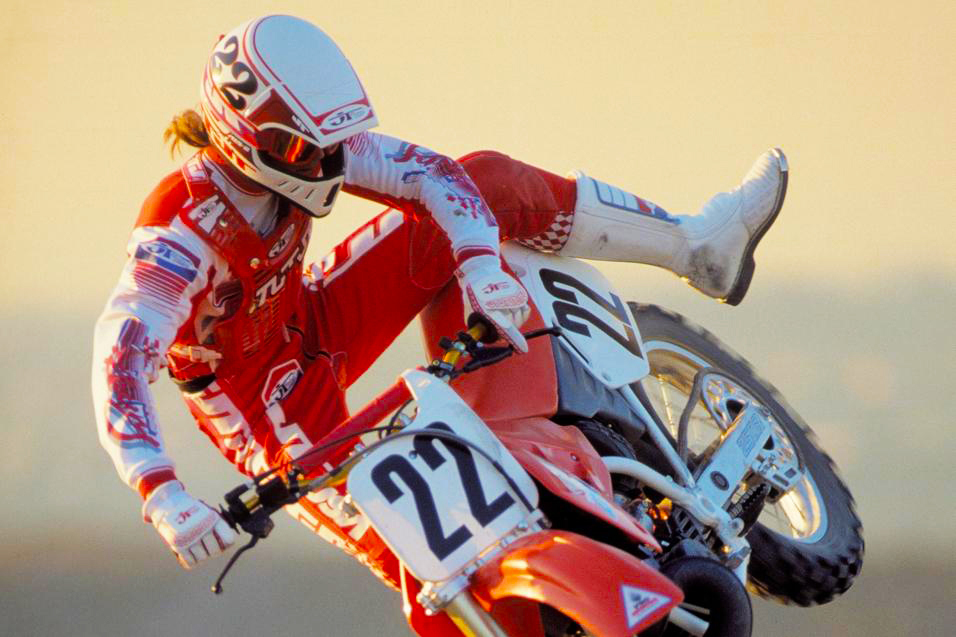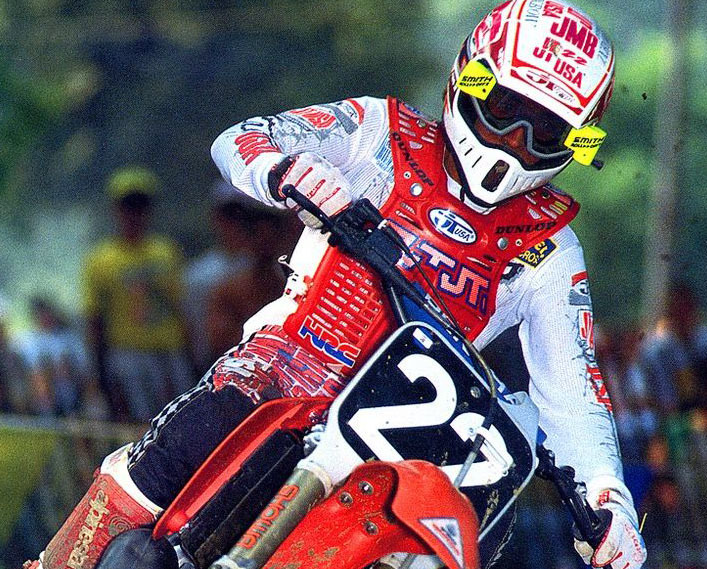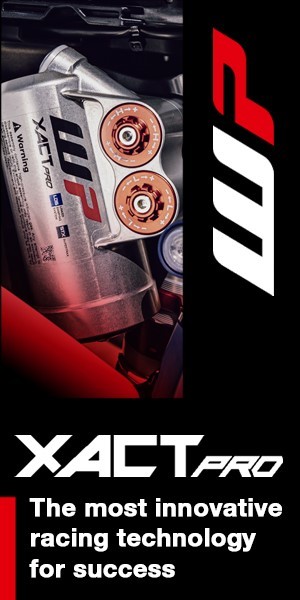Bayle and USA - Interview
Posted on November 18, 2020
If only he had stuck around in the sport, there is every chance that Frenchman Jean Michel Bayle would have been the greatest rider our sport has ever seen. Instead, he won five major titles in four years and then disappeared.
Several years ago, European cable channel Eurosport did a very cool interview with French legend Jean Michel Bayle (I am guessing done by Pascal Haudiquert). The two-time World motocross champion and three-time AMA supercross and motocross champion might have been the best rider the sport has seen, but a career of just a handful of years saw him arrive, dominate and then leave as quickly as he had arrived.
World championships in 1988 and 1989 before heading to America where he grabbed the 1991 AMA 250 and 500 motocross championships and also AMA supercross champion. Only injury in America in 1990 probably stopped the French wonder from winning more as he led the AMA 125 motocross championship but went out injured with four rounds remaining. By 1992 he was gone, racing MotoGP for Honda.

Yes, in the span of four years he had scored five major AMA and FIM championships, something never done before or after and probably never will equalled.
Heading to USA?
Bayle: It was the ultimate goal. I was playing in a real-World championship, but the real recognition was going to the United States. The supercross had arrived in Europe by the supercross of Bercy, in 1984. And at that time, the French, the Europeans were being jostled by the Americans. As a kid, I had seen the Bercy SX and told myself that we should show them that we can do like them. I grew up with this in mind: to go to the United States, to measure myself against the Americans, in their championship.
AMA Supercross?
Bayle: Since 1984 my goal had been the SX US and I trained accordingly. I was world champion in MX 125 and MX 250, but it had to move forward very quickly because I had specific goals to achieve. These two titles in the middle of this period were almost a formality before leaving for the United States.
AMA Licence?
Bayle: There were two problems: the American Championship was a national championship, whereas today it is an international championship. To run there, you needed an American license and live in the United States. Suddenly, I had to ask for a stop of my French license, and the French federation did not understand very well. They thought I was going to emigrate for extra sporting, financial or other reasons, when I just wanted to show that a Frenchman could win in the United States. The proof: even though I raced under an American license, I have always displayed my French identity.

Bayle: Yes. When I ask to leave the (French) federation at the end of 1988, I am 125 World champion. I get my license on the last day of 1988 or the first of 1989 - I don't know anymore -, and I compete in my first SX five days later. I do it as a private person while in the world championship I am an official pilot. In the United States, I find a little help from my manager Roger De Coster, who is also responsible for the Honda team in the United States, who was ultimately the trigger for it all. Thanks to him, I started to participate in a few races, even though Honda was not officially helping me.
Living in America?
Bayle: Absolutely, American life was different from what I had in France or in Europe, but that was part of the challenge, things to overcome. Winning in the United States didn't necessarily mean having a good time.
US Schedule?
Bayle: Indeed: the 18 races follow one another almost without a break from the beginning of January to the beginning of June, with a lot of trips in the middle. I see that physically there should be no problem, that it is really extremely violent, that the drivers are very prepared, and much more aggressive than in Europe and in the World Championship. For me, the first races are difficult, with a lot of crashes and mistakes on my part. But I got used to it quickly and I signed a podium in the fifth race (second in Miami). And I manage to win a national Championship event just before returning to Europe, to attack the MX 250 World Championship. In fact, I had shown my abilities to all the decision-makers. Until getting a contract with American Honda at the end of the year.
Racing For HRC In USA?
Bayle: Yes, especially at that time. It was huge. American Honda, it was big names like Roger de Coster (his manager), American stars like David Bailey, Ricky Johnson. I had the feeling of signing in a team where the best pilots had passed.
Testing in USA?
Bayle: While doing tests, we quickly realized that it was very difficult to tell the difference in all sections of jumps, turns. We were all still good, we all had good bikes and we all had trouble overtaking. With Roger, we reflected on that and we realized that it was in these whoops that there was the most to gain. So, we decided to put a lot of energy into this. For me in terms of driving, and for Roger in the technique of motorcycles in order to take a real step forward. By force, the click arrived: when the whoops were still in first or second, we said to ourselves that we should not hesitate to enter in third or even fourth to help the suspension work, so that the squat chain - that is, the motor that pulls on the chain - helps compress the suspension while accelerating. We managed to find adjustments and that allowed me to improve my technique. We really took a step forward in the test, and it really stood out in the race. So much so that when we arrived on a circuit, the drivers and team managers counted the whoops. From a certain number, they were pretty sure that I would make the difference and win. It went that far.
Testing With Americans?
Bayle: Yes, but all the pilots who dominate at one time necessarily bring something new in technique on a specific point. McGrath brought the dampers on the jumps, Stewart the scrubs, etc… Of course, when it comes to whoops, we innovated a lot back then and everyone wanted to do what we were doing.
1991 AMA Supercross Title?
Bayle: In 1991, the ultimate goal was the supercross title. It was really the goal of my life, the one I had since I was a kid. Everything I had built before had been built for this purpose. The championships overlapped for about a month, and at one point I sacrificed the MX 250 a bit. The races I felt good in, I was attacking to win them. In those which were more difficult, I knew how to settle for a podium. On a long championship, you have to manage. With the SX title in my pocket, I focused on the MX 250 and realized that being consistent effectively eliminated inconsistent rivals. In the end, I won the MX 250 quite easily, winning few races. I then managed to become champion in MX 500. The treble, nobody had done in the history of the championship.
Jeff Stanton?
Bayle: Stanton had all the technical advantages I could find, even if it took about a week to test them and apply them on his bike. It didn't make it easy for me but at the same time, having beaten him on an equal footing had a lot more value.
Who Inspired Him?
Bayle: We are always inspired by a style, which we try to copy. The first person I admired was Jean-Jacques Bruno: he was the first French driver to win GPs. Then there was Jacky Vimond, the first French world motocross champion. And in the United States, it was David Bailey, who had incredible technique and really impressive ease of piloting. Of course, I tried to copy his style, to come closest to him. What is most striking is that about three years before I arrived in the United States, he had an accident which left him paralyzed. At American Honda, I picked up his mechanic. For me it was amazing. Even he saw in me the technique I had taken from his former pilot. It was an incredible coincidence.
Becoming an AMA Legend?
Bayle: Yes, but at the time, I was the first foreigner to ride in this championship, and to win. At the start, when I wasn't winning, the reception was good; it was even exotic to have a European, a French. After one or two wins, they thought it was fun, but when I started chaining them, leading the championship, dominating it, it was a little more difficult. The organizer communicated around this war of the Americans against the French. And for the American public, which loves its pilots, it was enough. Personally, it didn't affect me; it even strengthened my motivation and my driving. Today, people understood that I had come for sport, not to prove that France was better than the United States. I came to pilot with them, according to the same rules, under the same conditions. A year ago, I was at the SX in Anaheim, signing in a booth with one of my old bikes displayed. A fan came to me to say: "You know, when you were driving here, I was one of those who criticized you the most. I was the one who hissed at you the most when you were introduced. excuse today ". It really touched me. This guy understood that I had come because I was passionate about motorcycles, that I had not come from abroad, with prejudices. I found his words, twenty-five years later, quite moving. I had come to accomplish my goal, my dream, and I had not cheated. When I do an interview in the United States, I never forget to thank the American people, the American federation for accepting me, for allowing me to measure myself against them. Even today, an American driver who wants to come to the French championship cannot score points during his first three seasons. We say we are open in France but that is not the case. In 1990, when I wanted to do the US championship like the locals, they said "Yes, of course".
Being Remembered in America?
Bayle: The Americans were marked by my 1991 season. When you look at the record of the US championship, you see "United States", "United States", "United States" ... then "France" in 1991. It stays. They welcomed me to this Hall of Fame because they understood my approach.
Racing Number 111?
Bayle: Yes. But in fact, in the United States, the numbers were assigned according to the place in the Championship, the points scored the previous season. And when we had not scored points on American territory, we had necessarily a number exceeding 100. I was offered the first available, 104, but Roger suggested 111 by saying "This is the number. I was running with. "
Opening The Door for French Riders?
Bayle: It gave me pleasure to serve as an example, to pave the way for others, who had facilities that I did not have: it was easier to sign contracts, the organizer, the team managers, found it nice that the French came. Today, that has changed a bit as the seriousness was not always there on the part of some French drivers. But it's still a demonic challenge to go out there and win.











